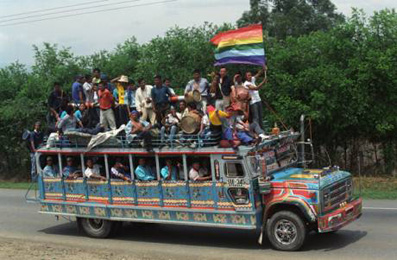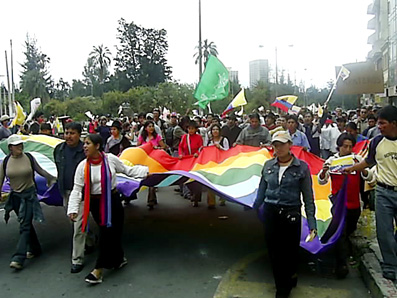 |
Peoples' movements and protests |
 |
|
MobilizationsWomen’s movementsFrench Revolution19th century republican movementThe black movement in the United StatesThe black movement in South AfricaNative American movementsBack to Civil rights movementsBack to main page
|
Native American movements
The people of America were subdued for centuries after
1500 successively by settler settlers from Europe. These treated
the Americans in one of two ways: If these lived sparsely and were too few to exploit profitably, they were exterminated or chased away. The indigenous peoples defended themselves locally. The landless farmers could revolt against delivery obligations and taxes, which could sometimes lead to their burdens becoming less burdensome. During the twentieth century, from Mexico in the north to Chile in the south, they engaged in land reform movements. They then organized themselves as villagers, ”campesinos” and sometimes had some success with this. The expelled tried to make peace by retreating even further, usually successfully in South America until the middle of the twentieth century, but in North America they were pressured so hard that they often tried to defend themselves by force, always with disastrous results. During the boom of the popular movement 1965-1975, they began to increasingly seek a common identity and defend themselves together. The pioneers were the North American Indians who used both legal means and the kind of crowd-pleasing means the black civil rights movement<LÄNK> had introduced to defend their land. However, it was in South America that the Indian movement became strong – understandably so because the North American Indians are few. It grew out of three mobilizations that were strong individually. The Amazon movement against the encroachment of forest companies, livestock farmers and mining prospectors. It proved extremely skilled in using solidarity movements in the North to defend itself. The peasant movement in Bolivia. It had won its land reform goal as early as the 1950s but soon found that the land was in the hands of financiers and city authorities. The Indian identity was first asserted by newly arrived city dwellers who were confronted with the Spanish-speaking middle class, but it soon became attractive to the peasants as well. The alliance between peasants and cultural Indian activists in the cities soon became strong enough to establish the peasant movement as the establishment's main challenger, winning general elections again and again. The broad civic movement in Ecuador, which in turn was an alliance between forest Indians in the Amazon and a peasant movement. This movement has carried out general strikes and overthrown several governments and it claims that all peasants are Indians, even if they are black. The event that established the Native American movement as a collective actor across the American continent was the foolish move of the settler colonists to try to commemorate the five-hundredth anniversary of their conquest in 1992. Thanks to Native American mobilization, this celebration could not take place anywhere (except in the Dominican Republic).
Reading
|

